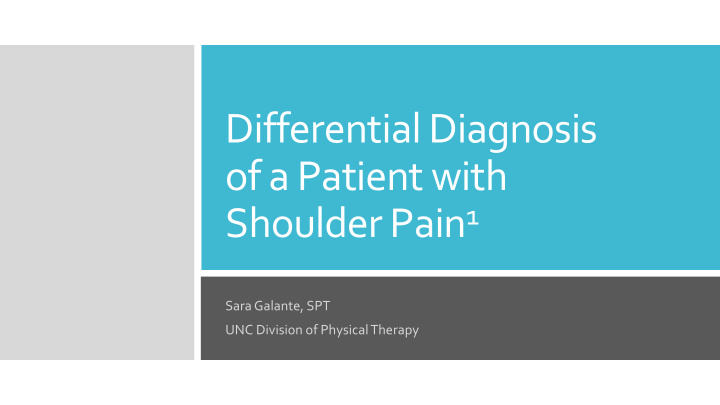



Differential Diagnosis of a Patient with Shoulder Pain 1 Sara Galante, SPT UNC Division of Physical Therapy
Tell me what’s going on today? 40 yof R shoulder pain Onset 1 mon ago “Grinding quality” Sensation of joint ”displacement” with lean to R side Chronic joint pain
Chronic Joint pain at 12 yo Review of Systems Injury-Prone Child GI Problems (IBS) Orthostatic Type 2 Diabetes hypotension PMH TMJ Dysfunction Hyperlipidemia Chronic Headache Vitamin D Deficiency Chronic Joint Pain Sensitive, Itchy & Fatigue Skin Daughter tested for POTS
The Beighton Scoring B 5 th digit ext Normal Strength 1. to dorsum of Throughout L hand Pain with palpation to R Objective 2. Thumb to Rotator Cuff forearm B Exam Integumentary 3. Elbow hyper- Abnormally soft skin extension ! Flexible and Hypermobile 4. Knee hyper- Outcome Measure? extension 5. Palms flat on ! floor Total = 5/9
5/9 Beighton Score Hx of widespread joint pain Ehlers- Spontaneous joint injury Fatigue Danlos TMJ dysfunction Diagnosis? Syndrome Soft skin (Hypermobility Postural hypotension IBS Type) Chronic Headache Family hx?
Ehlers-Danlos Syndrome (EDS) Group of heritable connective tissue disorders, caused by abnormal collagen formation 1 2017 criteria divided EDS into 13 types 2 Substantial overlap between EDS types and other CT disorders 3 Prevalence : 1 : 5,000 people 2,4 RF : non-white, female, family hx 2 Zhou et al. 2018
Disagreement in the literature regarding difference between Joint Hypermobility Syndrome (JHS) and hEDS Joint hypermobility is a symptom (Marfan, Loey-Dietz) 5 Consider a continuum of hypermobility 3-5 Increasing severity of s/s h EDS Asymptomatic Symptomatic hEDS Joint Hypermobility Joint Hypermobility Functional defect in collagen affects all organs with presence of collagen 2 Joints, ligaments, skin, tendons, blood vessels, GI tract, etc. Individual manifestations will vary 2
2017 Clinical Diagnosis Tool 3,5 *Unlike the other 12 types (presence of 3 criteria) of EDS, there is no known genetic marker to 1. Generalized Joint Hypermobility diagnose hEDS. Beighton Score 2. At least 2 of the following: Systemic Manifestations of CT disorders Diagnostic Positive Family Hx MSK Complications Criteria for 3. Absence of excessive skin fragility, exclusion of other CT hEDS disorders or other causes of hypermobility
S/S & Comorbidities Pain (B, Chronic) Headache Kinesiophobia TMJ Dysfunction Soft, ”velvety” skin Sleep Disturbances Fatigue Depression POTS Anxiety Orthostatic Intolerance Pelvic Floor Dysfunction GI Disorders Proprioception & Balance Problems Hx of dislocations OA Zhou et al. 2018
S/S & Comorbidities Pain (B, Chronic) Headache Kinesiophobia TMJ Dysfunction Soft, ”velvety” skin Sleep Disturbances Fatigue Depression POTS Anxiety Orthostatic Intolerance Pelvic Floor Dysfunction GI Disorders Proprioception & Balance Problems Hx of dislocations OA Zhou et al. 2018
S/S & Comorbidities Pain (B, Chronic) Headache Kinesiophobia TMJ Dysfunction Soft, ”velvety” skin Sleep Disturbances Fatigue Depression POTS Anxiety Orthostatic Intolerance Pelvic Floor Dysfunction GI Disorders Proprioception & Balance Problems Hx of dislocations OA Zhou et al. 2018
Cardiology à rule out vascular involvement (aortic root dilation) Finally having a diagnosis changed Pain clinic à everything! pharmacotherapy Rheumatologist à Revisiting screening for arthritis PT à pain management & pt education our Patient 1 EDS is often unrecognized for years, making the pt feel discredited and isolated
PT Treatment 2,6 Most undiagnosed cases of Pt education hEDS will warrant a non- Pain management immediate physician Lifestyle referral. Modifications Referrals & Pt presents with s/s that Low-impact would require emergent resistance training Treatment management in the Proprioception general population training (dislocated shoulder, Bracing, Splinting syncope) make an immediate medical **PT should be aware of referral. potential complications and monitor patient closely
Strengths Weaknesses • Good case overview & • No PT perspective pathology description • Old EDS Classification • Pt presentation System matches s/s & • Did not use specific Article Review 1 comorbidities EDS Diagnostic • Fantastic clinical Criteria reasoning • No Differential Dx List • Includes treatment • Level 5 Evidence and psychosocial impacts of disease
Questions?
Bibliography 1. Cohen S, Markham F. Ehlers-Danlos hypermobility type in an adult with chronic pain and fatigue: a case study. Clin. Case Rep. 2017;5(8):1248-1251. doi:10.1002/ccr3.1046. 2. Zhou Z, Rewari A, Shanthanna H. Management of chronic pain in Ehlers-Danlos syndrome: Two case reports and a review of literature. Medicine 2018;97(45):e13115. doi:10.1097/MD.0000000000013115. 3. What are the Ehlers-Danlos Syndromes? | The Ehlers Danlos Society : The Ehlers Danlos Society. Available at: https://www.ehlers-danlos.com/what-is-eds/. Accessed February 8, 2019. 4. Tinkle B, Castori M, Berglund B, et al. Hypermobile Ehlers-Danlos syndrome (a.k.a. Ehlers-Danlos syndrome Type III and Ehlers-Danlos syndrome hypermobility type): Clinical description and natural history. Am. J. Med. Genet. C, Semin. Med. Genet. 2017;175(1):48-69. doi:10.1002/ajmg.c.31538. 5. Brody L, Thein-Nissenbaum J. How Loose is TOO Loose? The Female Athlete and Hypermobility. APTA Combined Sections Meeting 2019. 6. Engelbert RHH, Juul-Kristensen B, Pacey V, et al. The evidence-based rationale for physical therapy treatment of children, adolescents, and adults diagnosed with joint hypermobility syndrome/hypermobile Ehlers Danlos syndrome. Am. J. Med. Genet. C, Semin. Med. Genet. 2017;175(1):158-167. doi:10.1002/ajmg.c.31545.
Recommend
More recommend